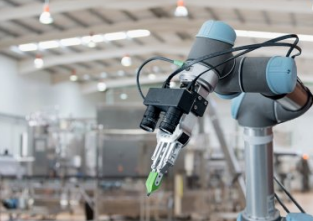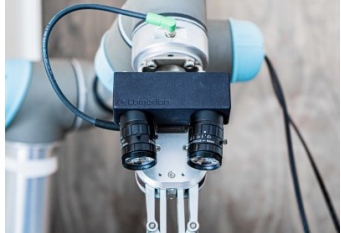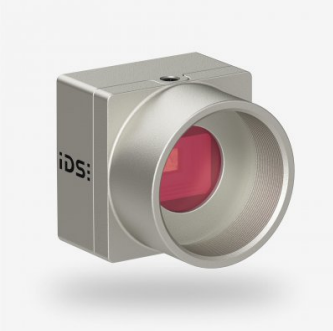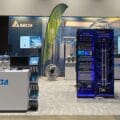3D image processing solution with 2D cameras, AI and robotics optimises the manufacturing landscape

The manufacturing sector is currently facing a number of challenges. Technological change, pressing
environmental issues and globalisation require a number of adjustments, such as investing in new
technologies, conserving resources and optimising and securing supply chains. Globally operating
companies have to face a changing environment and at the same time manage problems in supply chains.
Shifting production back to the domestic market is increasingly an option. This requires not only resilience,
but also compliance with strict environmental regulations and cost-efficient strategies to make domestic
manufacturing competitive. Moreover, those who want to ensure the competitiveness of domestic production
must overcome personnel bottlenecks. Automation through robotics has long since become the driving force
here, and artificial intelligence (AI) is increasingly taking on a key role. This technology is developing just as
rapidly as the pressure for automation is increasing. In order to map production processes in one’s own
company with AI, the simplest possible AI integration and the shortening of training phases are already
decisive factors.
This is where British start-up Cambrian Robotics Limited comes in with a fully AI-based solution for various
robotics applications in manufacturing. It takes over fast bin picking or pick-and-place, the exact feeding of
parts for machines as well as different work steps in material handling – for the benefit of more efficiency in
assembly tasks or in warehouse logistics. The easy-to-integrate system consists of a module for robot arms,
a computing unit with pre-installed intelligent software and a camera module, each equipped in series with
two uEye+ XCP cameras from IDS

A robotic arm locates and grips parts with the help of two IDS cameras and intelligent Cambrian software
The task of the cameras is to take a picture of the area with the objects to be handled. Based on the
recordings, the software can analyse the scene and recognise where exactly the objects are located,”
explains Miika Satori, founder and CEO of Cambrian Robotics. Further processing of the images is carried
out with the help of the heart of Cambrian Vision – a specially developed, self-learning software for predicting
the position of the parts as well as their pick points. This takes care of the image matching on an AI basis, so
that no classic 3D point cloud is needed. Based on simulated data, the AI learns independently and locates
the removal points and parts extremely precisely. The AI models for part recognition and communication with
the robot are controlled by a powerful GPU (Graphics Processing Unit). And the software learns quickly:
“With the Cambrian software package, pick points for new parts can be defined and the application
configured within just two to five minutes,” emphasises start-up founder Satori.
The associated camera module is equipped with two space-saving uEye XCP industrial cameras. “The two
IDS cameras provide images of the object scene from different viewing angles according to the stereo vision
principle. The challenge is to determine the position of the part to be gripped as accurately as possible from
these images. This is again the task of AI,” says Miika Satori. The combination of image acquisition, AI
models and special image processing makes it possible to determine recording points and positions
particularly precisely. “Standard CAD applications for 3D bin picking often use structured light or sensors to
do this, projecting something onto the environment, creating a point cloud and then trying to find the part in it.
Cambrian uses only two standard IDS industrial cameras instead of a 3D camera.

Two IDS cameras on robot arm provide images for fast and accurate further processing using intelligent
software
With an accuracy of less than one millimetre, Cambrian Vision is also much more precise than competing
systems. “The system reliably detects a wide range of parts, including shiny, reflective or transparent
components, where conventional machine vision systems often reach their limits. At the same time, it
remains robust against external light conditions,” says Miika Satori, describing the special requirements for
the cameras, which are an elementary part of the solution. “It’s also super-fast, with an inference speed of
less than 170 milliseconds, whereas it often takes more than 1000 milliseconds for comparable solutions.”
The fast calculation time allows cycle times of two to three seconds in a bin-picking setting. “This ensures
efficient, precise and accurate execution in a single pass,” Miika Satori underlines. This makes the One-Shot
system currently one of the fastest AI image recognition systems on the market.
This is made possible not least by the SuperSpeed USB 5 Gbps cameras, which reliably deliver high-resolution data for detailed image evaluations in any environment,
explicitly in applications with low ambient
light or changing light conditions. Thanks to BSI (“Back Side Illumination”) pixel technology, the integrated
sensor (1/2.5″ 5.04 MPixel rolling shutter CMOS sensor onsemi AR0521) offers stable low-light performance
as well as high sensitivity in the NIR (near infrared) range, so that the uEye XCPs deliver high-quality images
in almost any lighting situation – with low pixel noise at the same time. With its compact, lightweight full
housing (29 x 29 x 17 millimetres, 61 grams) and screwable USB Micro-B connector, the USB3 XCP is
particularly suitable for use in combination with robots and cobots in the field of automation.
Thanks to USB3 and Vision Standard compatibility (U3V / GenICam), the XCP cameras can be easily
integrated into any image processing system and can basically be used with any suitable software. The
simple integration via the standard interface is particularly advantageous for Miika Satori: “Depending on the
customer’s requirements, we use other IDS cameras in our system. The standardised interface enables rapid
deployment of a wide variety of uEye models.” Compatible with popular lenses, a wide range of cameras
from the IDS portfolio can be used as eyes for custom Cambrian Vision solutions, helping to maximise
production performance.
The top speed, the particularly high light insensitivity and the wide component bandwidth that the
system achieves thanks to the powerful IDS cameras and intelligent software make it particularly
interesting for automation tasks in the production environment.

A powerful CPU controls the AI models for part recognition and communication with the robot
Another key to efficiency lies in the uncomplicated integration of Cambrian Vision. The intelligent 3D vision
system is ready for immediate use without any real robot training – a remarkable acceleration compared to
conventional methods. Companies can therefore quickly reap the benefits of automation: They conserve
resources and save costs by operating more efficiently, competitively and sustainably, while improving the
quality of their products and the safety of their employees.
Outlook
“The use of AI in robotics is still in its infancy,” says Miika Satori. Due to the growing demand, the
development in the field of image processing with AI will be further advanced, cameras with higher data rates
and faster and larger sensors will come onto the market, as well as further price-optimised models with
reliable basic functions. “Industrial cameras are getting smaller and more affordable. This will enable even
more applications. Our vision is to give robots capabilities on the same level as humans.” By using AIpowered robots for mundane and repetitive tasks, human resources can be redirected to more creative,
productive and valuable tasks.
Camera
uEye XCP – the industry’s smallest housing camera with C-mount
Model used: U3-3680XCP
Camera family: uEye XCP

Client
By combining robotics and artificial intelligence, Cambrian Robotics is developing a productive tool that
replaces human hands in the manufacturing of products. With the help of intelligent automation, costs are to
be reduced and people are to be given more time for meaningful tasks. Cambrian Vision is a fully AI-based
solution for various robotics applications in manufacturing such as bin picking, assembly, feature recognition
and localisation, pick and place, placement, wire harness and cable assembly.





